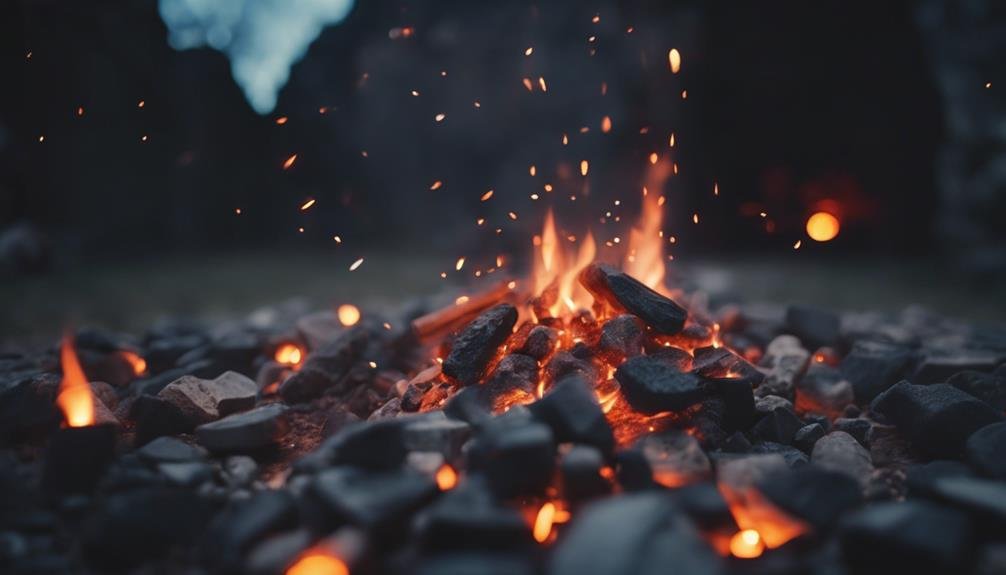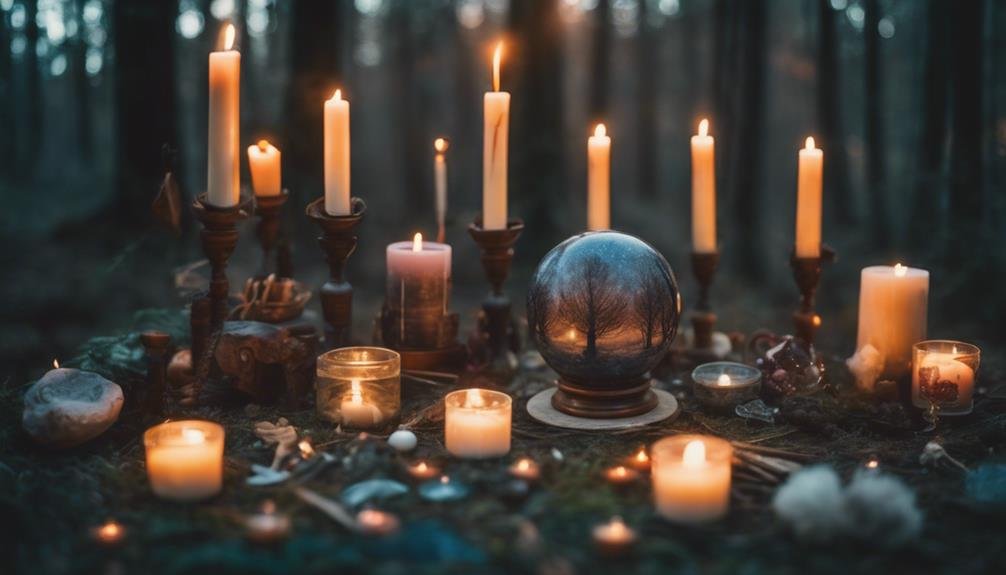When you think about divination, you’re likely to picture tarot cards or crystal balls, but the history of divination devotion is far richer and more complex.
Originating in ancient civilizations like Egypt and Greece, these practices evolved through the Middle Ages and Renaissance, deeply intertwining with spiritual and religious life.
Rituals, offerings, and prayers became essential components, each with unique significance. Imagine the secrets passed down from mother to daughter or the sacred moments at holy wells.
The adaptability of these practices across different eras and cultures has guaranteed their survival, but have you ever wondered why they’ve endured so persistently?
Key Takeaways
- Divination devotion has roots in ancient civilizations like Egypt, Greece, and Mesopotamia.
- Middle Ages divination intertwined deeply with religious and spiritual life.
- We celebrated diverse divination methods blending ancient and contemporary philosophies during the Renaissance period.
- Recommenders in Limousin used coal rituals to trace malevolent energies and offer remedies.
- Holy wells in Limousin were focal points for spiritual healing and purification.
Historical Background

Divination devotion stretches back to the ancient civilizations of Egypt, Greece, and Mesopotamia. These cultures laid the foundation for practices that would evolve through the centuries.
As you delve into the historical background, you’ll find that the Middle Ages and Renaissance periods were particularly notable for their rich tapestry of divination practices.
During the Middle Ages, divination became intertwined with religious and spiritual life. People sought guidance from higher powers through various means, including astrology, scrying, and the casting of lots.
Rituals, offerings, and prayers were essential components of these practices, aiming to connect with spiritual entities and gain insights into the unknown.
The Renaissance period saw a resurgence in the interest and sophistication of divination practices. Scholars and mystics revisited ancient texts and philosophies, merging them with contemporary thought.
This era celebrated the diversity of divination methods, from tarot reading to alchemy, reflecting a deep-seated devotion to understanding the mysteries of existence.
Role of Recommenders
As the Renaissance celebrated the diversity of divination methods in Limousin, France, recommenders emerged as pivotal figures in identifying and combating evil forces. These women diviners, known as recommenders, skilfully used coal rituals to trace the sources of evil energies.
Their healing traditions were not bound by strict doctrine but flowed with adaptability and a deep connection to spiritual guidance. Recommenders played an essential role in their communities by offering spiritual guidance and recommending holy wells for deliverance and healing.
The transmission of their secrets and gifts from mother to daughter ensured the continuity of their sacred practices. Their work was marked by a fascinating ambivalence involving gifts, fountains, and saints. This ambivalence often evoked strong emotions among those seeking their help.
Here’s a glimpse into the emotional world of recommenders:
| Emotion | Source | Impact |
|---|---|---|
| Hope | Holy wells | Healing and deliverance |
| Fear | Evil forces | Need for protection |
| Trust | Recommenders | Spiritual guidance |
| Mystique | Rituals | Transmission of secrets |
| Comfort | Traditions | Community support |
These women were more than just diviners; they were the spiritual anchors, guiding their communities through the enigmas of life and the shadows of evil.
Coal Rituals

Delving into Limousin’s coal rituals, you’ll discover how recommenders use this ancient practice to trace and combat evil forces. These women diviners, or recommenders, employ coal to uncover the origins of evil, a process steeped in ritual symbolism.
With its dark, elemental nature, they believe coal can reveal hidden truths and point to the source of spiritual afflictions. During the ritual, the recommender might place a piece of coal in water and interpret the patterns and movements to identify the evil force at play.
This practice isn’t just about detection; it also involves prescribing spiritual remedies. For example, a recommender might advise visiting holy wells or using sacred objects as part of the healing process.
The transmission of these divination skills from mother to daughter maintains that the knowledge and efficacy of the coal rituals remain intact. This generational passage highlights the importance of familial bonds in preserving the tradition.
The flexibility and lack of strict doctrine in these coal rituals reflect the broader ambivalence of healing practices in Limousin, where gifts, fountains, and saints all play crucial roles.
Holy Wells
In addition to coal rituals, Limousin’s recommenders often guide visitors to the region’s holy wells for spiritual healing and protection. These sacred waters are believed to offer a unique blend of folk traditions and mystical practices, making them a cornerstone of local spirituality.
When you visit these wells, you’ll experience:
- Healing Waters: The holy wells are renowned for their sacred waters, which locals claim can heal ailments and purify the spirit.
- Folk Traditions: You’ll witness centuries-old customs, including offering gifts or tokens to saints associated with the wells.
- Mystical Practices: The rituals performed at these sites lack formal doctrine, emphasizing adaptability and personal connection to the divine.
Jean-Pierre Cavaillé’s study explores how these wells serve as a focal point for divination, devotion, and identifying evil. Unlike rigid religious practices, the healing rituals here are fluid and personalized, allowing for a deep spiritual connection.
The recommenders pass down these practices through generations, ensuring the continuity of these mystical traditions.
Mother-Daughter Secrets

Women diviners in Limousin, known as recommenders, pass down their healing secrets and practices from mother to daughter, safeguarding the preservation of these ancient traditions.
This unique transmission highlights the importance of generational wisdom and familial traditions in upholding the integrity of their craft.
As a daughter, you learn the rituals and remedies, such as using coal to identify sources of evil and guiding the afflicted to holy wells for deliverance. These practices aren’t rigid; they adapt and evolve with each generation, reflecting the fluid nature of their application.
Your mother, a recommender herself, imparts the knowledge and the intuitive understanding necessary for effective divination.
These practices lack strict doctrine or orthodoxy, allowing you to personalize and refine your approach, making each diviner’s methods unique. This flexibility ensures the art remains relevant and effective, even as times change.
Healing Ambivalence
Healing practices in Limousin often blur the lines between traditional remedies and personal intuition, creating a dynamic interplay that defies strict orthodoxy. Here, you’ll find a rich tapestry of spiritual traditions where healing isn’t confined to a single method or belief system.
Instead, it’s a fluid mix of ancient and intuitive practices handed down through generations. Women diviners, or recommandeuses, play a pivotal role in this landscape. They use coal rituals to identify sources of evil and direct people to holy wells for deliverance.
This method is as much about spiritual insight as practical remedies. Healing practices in Limousin exhibit a unique ambivalence, making room for a personalized approach to well-being. Imagine the process with these vivid elements:
- Holy Wells: Sacred waters believed to hold curative powers.
- Coal Rituals: Mystical ceremonies to unearth hidden sources of trouble.
- Saints: Revered figures whose blessings are sought for healing.
This ambivalence in healing practices highlights the balance between structured spiritual traditions and the intuitive, often improvised, methods that cater to individual needs. This very blend makes the healing practices in Limousin both enigmatic and effective.
Adaptability in Practices

As you explore the healing practices in Limousin, you’ll notice their remarkable adaptability. They seamlessly blend ancient rituals with evolving beliefs.
The women diviners, or recommenders, showcase adaptable traditions by using coal to identify sources of evil. This method, passed down from mother to daughter, highlights a transmission of secrets and gifts that have kept these practices alive and relevant.
The recommenders’ rituals are notable for their lack of doctrinal or orthodox constraints, allowing for a flexible approach to divination. This flexibility guarantees that the practices remain resilient despite changing societal norms and beliefs.
At holy wells, where divination often takes place, you can witness the versatility of these resilient rituals. The blend of gifts, fountains, and saints emphasizes the ambivalence and adaptability inherent in Limousin’s healing traditions.
Conclusion
You’ve journeyed through divination devotion’s rich history and evolution, witnessing its roots in ancient civilizations and its transformation through the ages.
By understanding the role of recommenders, the significance of coal rituals, holy wells, and mother-daughter secrets, you can appreciate how these practices have provided guidance and healing.
The adaptability of these traditions highlights their enduring relevance. Embrace this wisdom, and let it inspire your spiritual journey and connection.
FAQs
What is the difference between divination and devotion?
Divination seeks knowledge about the future or the unknown through supernatural means, such as tarot cards, astrology, or other fortune-telling methods. It involves interpreting signs, symbols, or omens to gain insight into events or decisions.
Conversely, devotion is a spiritual practice that involves dedicating oneself to a deity or higher power through worship, prayer, and reverence. It expresses faith and loyalty, often focused on building a personal relationship with a divine being rather than seeking predictive knowledge.
Key Differences:
- Divination: Seeks insight into the future or unknown events through supernatural means.
- Devotion: Focuses on worship, prayer, and connection to a deity or higher power.
Is divination allowed in religious devotion?
In many religious traditions, divination is discouraged or forbidden, as it is seen as conflicting with faith and trust in divine guidance. For example, in Christianity, the Bible warns against divination, as it encourages reliance on God’s will rather than trying to predict the future through other means.
However, some spiritual traditions may incorporate divination into their religious or cultural practices, seeing it as a tool for gaining clarity and guidance.
Religious Stances:
- Christianity and others: Divination is often discouraged or forbidden.
- Other spiritual traditions May incorporate divination as a tool for guidance.
What are common types of divination practices?
There are various forms of divination used across different cultures and belief systems. Some common types include:
- Tarot Reading: Using a deck of tarot cards to interpret messages about a person’s life, challenges, or future.
- Astrology: The study of the positions and movements of celestial bodies to predict events and gain insight into personalities and life paths.
- Palmistry: Reading the lines on a person’s hand to reveal information about their life and future.
- Runes: Interpreting symbols from an ancient alphabet to gain insight or predict future events.
Common Types:
- Tarot, astrology, palmistry, and runes.
How does devotion shape spiritual practices?
Devotion involves consistent worship, prayer, and ritual to deepen relationships with a deity or higher power. It often shapes daily routines, such as prayer times, participation in religious services, or personal acts of dedication, such as fasting, meditation, or offerings. Devotion fosters a sense of trust, reverence, and commitment to spiritual growth, focusing on surrendering to divine will rather than seeking control over the future.
Key Practices:
- Prayer, worship, and ritual.
- Fasting, meditation, and personal offerings.
Can divination and devotion coexist in spiritual practice?
In some spiritual traditions, divination and devotion can coexist. For example, practitioners of certain pagan or indigenous faiths may use divination methods, such as reading runes or consulting oracle cards, while practicing devotion through rituals, offerings, or prayers to their deities. These traditions view divination as a means of gaining insight while maintaining reverence for higher powers.
However, in monotheistic religions like Christianity or Islam, divination is often seen as incompatible with devotion, as it may undermine reliance on divine guidance.
Coexistence:
- Can coexist in certain spiritual traditions (e.g., paganism).
- Typically incompatible in monotheistic faiths.

